

Underfloor heating is normally efficient because it effectively turns the whole floor into a radiator. The large surface area means it doesn’t have to be a high temperature to warm the room – only a couple of degrees warmer than normal room temperature. It can be expensive to install (especially if retrofitted) but can lead to energy savings in the long run. It uses 15-40% less energy than traditional radiators.
Underfloor heating pros
- Efficient.
- It can be laid in new and old homes.
- It doesn’t take up wall space or dictate where you can put furniture – and it doesn’t show, unlike radiators!
- Even distribution of heat – radiators concentrate heat in one spot, and the heat rises to the top of the room, where it’s not helping anyone! Non-standard room shapes can also have cold spots where the heating does not extend to.
- Warm feet! There is definitely a certain luxury in the radiant heat of underfloor heating.
- Does not circulate dust/allergens, unlike traditional central heating systems.
- Some systems can be installed yourself if you are a competent DIYer! A single-zone wet underfloor heating kit can cost as little as £300.
- Operates silently.
Underfloor heating cons
- Installation is expensive if not done yourself.
- The effects are not instantaneous; it can take up to two hours to heat a room.
- Only works with certain types of flooring; heat may struggle to transfer through carpet.
- It may restrict what furniture you can use.
- Maintenance can be tricky if something goes wrong.
- Won’t help you dry clothes – you can’t put a towel rail on the floor!
Radiator pros
- Quick to heat up.
- Easy to use.
- Low-maintenance.
Radiator cons
- Takes up space.
- Heat rises, so some heat is lost through the ceiling rather than circulating into the room, whereas underfloor heating heats from below.
- Can look ugly.
- Can be noisy.
Conclusion
So is underfloor heating worth the cost? Or is it only good for warm feet? Underfloor heating can be a bonus, but more often than not the room will still rely on a humble radiator or alternative heat source in addition.
Think we missed something? Do you have a different opinion?
Comment below to get your voice heard…












I installed underfloor heating as part of a kitchen extension, I worried I would need a radiator as well to supplement the heat but this proved unfounded. It’s the best thing I did. The cost is loaded up front in terms of installation; in our case concrete had to be dug up to create enough depth to lay the pipes. Since then however running costs have been vastly reduced. I purchased my kit from these people and it was far cheaper than purchasing from the plumber: Underfloor Heating store.
I personally wouldn’t purchase electric underfloor heating, a friend did and her running bills are horrendous. I find with the continual heat of the just the kitchen on during winter, the radiators in the rest of the house are on less, with the kitchen heat radiating out further than I expected.
I would say underfloor heating however is regarding energy saving better for a long term has some negative financial effects.Just want to mention experience of friend of mine.Nevertheless a new technology which is being used for underfloor heating sometimes can fail and break down.The problem starts when complete floor has to be removed or partially and repaired underfloorheating.Of course it depend of used heating technology and a quality of the floor.Logically it’s easier to repair broken radiators.Still both solutions are good if quality equipment are professionally fitted .
I think you’ve missed an important point. No home will hold radiant heat unless it is well insulated. Even modern building code is insufficient to really reduce bills and keep homes warm with little radiant heat systems. Whether under floor or traditional heaters. More needs to be done to bring homes well beyond current building code practices. My home for instance built in 2004 has modern rads and double glazing but ambient temperatures in winter average 14 degrees in my living room! And there’s nothing I can do to better the situation. But developers don’t want to spend money and government don’t want to stamp down too much because they know it means less revenue to power companies. The only way around it…build your own home to higher code for sustainability!
Hi Chris,
Thanks for your comment. Our blogs tend to be more from a consumer point of view and what is the best choice for a customer in a particular scenario. Whilst insulating your property to the max is the ideal, it is often not practical to retrofit an existing property and a slightly more pragmatic approach is required.
Regards,
Alan
Underfloor heating does come with many pros and cons. But, I think it worth it- the pros outweigh the cons.
I run a duel heating system Both water and electric. The water system is controlled by a small radiator and the electric controlled by the normal heating controls. The electric heating is supplied by a solar panel arrangement providing a 12Kwh daylight capacity. The water heating is embedded within a 2 inch thick cement screed suspended on a 4 inch thick insulated support over a unheated basement. Above this insulation is the water heating and above that is the electric heating. The flooring is engineered flooring. This system is still under development but have already developed a 1000 sq foot area in my 6000 foot home.
As my property has no gas I want to compare running costs of electric underfloor heating v electric fan heating v electric wall mounted rads.
Then I want to compare the Materials cost. Then compare the installation cost. Can you tell me of a website that can give me this information? I do not wish to be inundated with advertising stuff and hope you will bear this in mind since you have my e-mail address.
Hi Bob – I’m in exactly the same situation you describe at the moment (July 2020). Did you reach any clear conclusions?
Thanks, Nick
Hi Nick – did you reach a conclusion on this? I’m looking into just the same thing now, but can’t find any information.
Im looking at buying a property with underfloor heating,not my choice and a bit concerned about its safety. Could i still have gas central heating install
I understand the underfloor heating can run at a lower temperature but why is that more economical? A kilowatt of energy heats up the room the same amount regardless of the temperature of that kilowatt.
It’s about efficiency. A kilowatt of energy is never converted 100% to a kilowatt of heat retained in the area you are heating. Convection heating’s higher losses are in the heat more readily escaping to the higher areas of the room.
Radiant heating (from underfloor heating) also does not heat the air as much as convectional heating from radiators. Heated air in areas people don’t spend time in is heat that does not serve its purpose – this is a loss of efficiency.
Of course, even UFH relies a bit on convectional heating. The difference are the percentages.
This article’s conclusion doesn’t really follow from the rest of it. It concludes (more or less) that it’s not really worth it because you will need an alternative heating source while the article itself says the underfloor heating is more efficient and has a more even distribution of heat. So why is it not worth it? In that way the article is suspect.
On the other hand, the first-hand accounts from people who have actually installed it and are actively using it would be most valuable.
Is underfloor heating worth it? I think a majority of people, as well as professionals, answer yes. I wonder why anyone would choose the traditional rads when they could have underfloor heating. I understand you don’t get that “blast” of heat that you might get from rads, but isn’t a more even, distributed, and ambient heat better? I usually get cold very quickly after stepping away from a radiator.
Is electrical underfloor heating too expensive? This article does mention that the underfloor heating only needs to rise a few degrees above room temperature to begin to have an effect. I’d love some first-hand accounts of how electricity bills have been affected after using electrical underfloor heating.
FYI: We had electrical underfloor heating installed in our bathroom and it was wonderful… we didn’t see any spikes in our electricity bills and that thing was on pretty much all the time. We have now purchased an old house (circa 1946) and want to know if it is feasible to have an entire house fitted with same, effectiveness and operating costs being the main issues we would like answers to.
Thanks!
Any thoughts on how underfloor heating compares to radiant ceiling heating? I can only find sources that are trying to sell ceiling heating, so not exactly unbiased. For example:
https://www.beka-klima.de/fileadmin/beka/pdf/Sonstige/beka_comparison_ceiling-heating-versus-traditional-underfloor-heating.pdf
If you’re fitting out a house anyway it seems to have lots of advantages, such as no floor interventions (you can have rugs), minimal room height loss, less likely to be damaged as not underfoot, a (claimed) lower operating temperature. However, there don’t seem to be many companies offering radiant ceiling heating in the UK. What do you think?